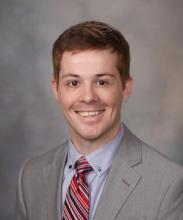A 46-year-old man presents to your clinic with hearing loss and ear fullness. He awoke with sudden and unexplained right-sided hearing loss with aural fullness 6 days prior to presentation and reports associated unilateral tinnitus and vertigo. He denies otorrhea and otalgia. Hearing on the left is otherwise preserved, and he has no prior otologic history. He denies inciting events. He has never experienced this before.
On examination, the auricles are normal, and there are no vesicular lesions. His ear canals are patent and without occluding cerumen. Tympanic membranes are translucent and intact without effusion or retraction. On tuning fork examination, Weber lateralizes to the left, and air conduction is greater than bone conduction bilaterally.
What is the most likely diagnosis?
A. Otitis media with effusion.
B. Ménière’s disease.
C. Ramsay Hunt syndrome.
D. Sudden sensorineural hearing loss.
E. Bell’s palsy.
F. Otosclerosis.
G. Benign paroxysmal positional vertigo.
This patient is presenting with sudden sensorineural hearing loss (SSNHL). There are approximately 4,000 new cases of SSNHL reported each year in the United States, and many primary care physicians will encounter this disorder.1
Idiopathic SSNHL is an otolaryngology emergency, and recognition and prompt treatment is imperative to potentially salvage hearing and improve quality of life.2 The rates of spontaneous recovery within the literature vary widely from 32% to 65%. However, this constitutes a significant portion of patients who still require the use of hearing aids. Recovery at lower frequencies occurs more commonly, and the rates of true spontaneous recovery are likely approximately one-third of all cases, with only 15% of patients who recover fully.3
Patients with SSNHL present to an otolaryngologist on average 55 days after symptom onset. Yet it is believed that the earlier the intervention, the more improved the recovery, especially if instituted within 1-2 weeks.4 Most patients, however, initially present to their primary care physicians.
The history and physical are particularly important to rule out other etiologies of hearing loss, including otitis media with effusion, acute otitis media, and cerumen impaction.
The onset and progression of SSNHL are unique, in that patients will experience near immediate unilateral hearing loss, typically with a normal ear examination. Aural pressure and tinnitus are frequently reported in SSNHL. In fact, ear fullness is the most common presenting symptom, and tinnitus is reported nearly universally. Dizziness or vertigo does not refute the diagnosis of SSNHL, as this occurs in 30%-40% of cases and is a negative prognostic factor, along with profound sensorineural loss, contralateral hearing impairment, and delayed treatment.3,5
In 9 out of 10 patients with SSNHL, a precipitating factor or cause will never be identified, and approximately one-third of patients will spontaneously recover hearing.6
This has created controversial treatment options. Regardless, specialty guidelines advocate for early medical treatment with systemic corticosteroids within the first 14 days of symptom onset. Clinicians must be prepared to empirically and rapidly treat patients with suspected SSNHL without understanding the etiology and without conclusive audiologic or imaging data.
Other causes indeterminate of sudden hearing loss include autoimmune and Ménière’s disease; however, diagnosis and management of these disorders does not have the same urgency as that of SSNHL.
Otolaryngology follow-up for SSNHL is recommended to provide treatment options and counseling, monitor hearing thresholds, provide ongoing evaluation for hearing augmentation, and establish expert consultation to ensure there are no underlying causes.
Primary care providers need to institute the initial treatment recommendations, which include systemic steroids, potentially in combination with alternative treatment options. There is conflicting evidence on the efficacy of early high-dose steroid therapy in SSNHL. But, unfortunately, the alternative may include permanent unilateral deafness.7 The earlier the treatment, the better the outcomes, although oral steroids may contribute to significant improvement even at late presentation.4
Dosing recommendations vary, but include prednisone 1 mg/kg per day (maximum of 60 mg), methylprednisolone 48 mg/day, and dexamethasone 10 mg/day for 7-14 days prior to tapering. Examination and audiometry are ideally obtained at the time of symptom onset and immediately after treatment for full evaluation.
Evidence supports the use of intratympanic steroid injections after primary treatment failure, although there is increasing interest in combining transtympanic perfusion with oral steroids for primary treatment.7,8 In a survey of otolaryngologists, 86% of respondents reported the concomitant use of intratympanic steroid injections for primary treatment.9 Of these, greater than 50% and 32% used steroid injections up to 1 month, and up to 3 months following the onset of symptoms, respectively.
There may be benefit with hyperbaric oxygen therapy, which is rarely used in the United States.6 There may be benefit with a low side effect profile in combining systemic steroids with antioxidants, such as vitamins A, C, and E.10
In summary, SSNHL is not uncommon; ear fullness and tinnitus are common and may represent the chief complaint. A high index of suspicion is necessary, and decisions are often made without full knowledge of the etiology. Conductive hearing loss should be ruled out on history and examination. Initial diagnostic workup includes formal audiometry with initiation of high-dose corticosteroid therapy, ideally within 2 weeks of symptom onset.
Consultation to otolaryngology or neurotology is important for ongoing discussions regarding potential recovery, hearing augmentation, and to ensure there is no underlying condition.


